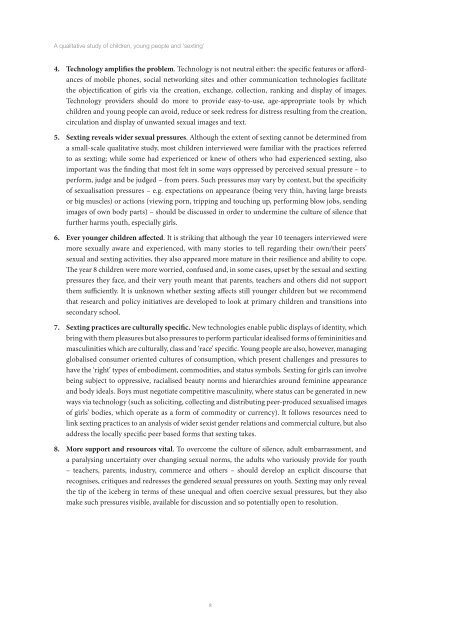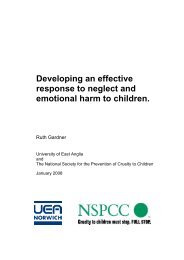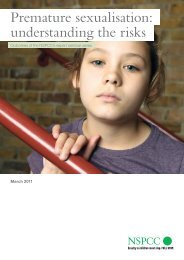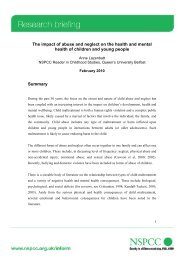A qualitative study of children, young people and 'sexting ... - NSPCC
A qualitative study of children, young people and 'sexting ... - NSPCC
A qualitative study of children, young people and 'sexting ... - NSPCC
Create successful ePaper yourself
Turn your PDF publications into a flip-book with our unique Google optimized e-Paper software.
A <strong>qualitative</strong> <strong>study</strong> <strong>of</strong> <strong>children</strong>, <strong>young</strong> <strong>people</strong> <strong>and</strong> ‘sexting’<br />
4. Technology amplifies the problem. Technology is not neutral either: the specific features or affordances<br />
<strong>of</strong> mobile phones, social networking sites <strong>and</strong> other communication technologies facilitate<br />
the objectification <strong>of</strong> girls via the creation, exchange, collection, ranking <strong>and</strong> display <strong>of</strong> images.<br />
Technology providers should do more to provide easy-to-use, age-appropriate tools by which<br />
<strong>children</strong> <strong>and</strong> <strong>young</strong> <strong>people</strong> can avoid, reduce or seek redress for distress resulting from the creation,<br />
circulation <strong>and</strong> display <strong>of</strong> unwanted sexual images <strong>and</strong> text.<br />
5. Sexting reveals wider sexual pressures. Although the extent <strong>of</strong> sexting cannot be determined from<br />
a small-scale <strong>qualitative</strong> <strong>study</strong>, most <strong>children</strong> interviewed were familiar with the practices referred<br />
to as sexting; while some had experienced or knew <strong>of</strong> others who had experienced sexting, also<br />
important was the finding that most felt in some ways oppressed by perceived sexual pressure – to<br />
perform, judge <strong>and</strong> be judged – from peers. Such pressures may vary by context, but the specificity<br />
<strong>of</strong> sexualisation pressures – e.g. expectations on appearance (being very thin, having large breasts<br />
or big muscles) or actions (viewing porn, tripping <strong>and</strong> touching up, performing blow jobs, sending<br />
images <strong>of</strong> own body parts) – should be discussed in order to undermine the culture <strong>of</strong> silence that<br />
further harms youth, especially girls.<br />
6. Ever <strong>young</strong>er <strong>children</strong> affected. It is striking that although the year 10 teenagers interviewed were<br />
more sexually aware <strong>and</strong> experienced, with many stories to tell regarding their own/their peers’<br />
sexual <strong>and</strong> sexting activities, they also appeared more mature in their resilience <strong>and</strong> ability to cope.<br />
The year 8 <strong>children</strong> were more worried, confused <strong>and</strong>, in some cases, upset by the sexual <strong>and</strong> sexting<br />
pressures they face, <strong>and</strong> their very youth meant that parents, teachers <strong>and</strong> others did not support<br />
them sufficiently. It is unknown whether sexting affects still <strong>young</strong>er <strong>children</strong> but we recommend<br />
that research <strong>and</strong> policy initiatives are developed to look at primary <strong>children</strong> <strong>and</strong> transitions into<br />
secondary school.<br />
7. Sexting practices are culturally specific. New technologies enable public displays <strong>of</strong> identity, which<br />
bring with them pleasures but also pressures to perform particular idealised forms <strong>of</strong> femininities <strong>and</strong><br />
masculinities which are culturally, class <strong>and</strong> ‘race’ specific. Young <strong>people</strong> are also, however, managing<br />
globalised consumer oriented cultures <strong>of</strong> consumption, which present challenges <strong>and</strong> pressures to<br />
have the ‘right’ types <strong>of</strong> embodiment, commodities, <strong>and</strong> status symbols. Sexting for girls can involve<br />
being subject to oppressive, racialised beauty norms <strong>and</strong> hierarchies around feminine appearance<br />
<strong>and</strong> body ideals. Boys must negotiate competitive masculinity, where status can be generated in new<br />
ways via technology (such as soliciting, collecting <strong>and</strong> distributing peer-produced sexualised images<br />
<strong>of</strong> girls’ bodies, which operate as a form <strong>of</strong> commodity or currency). It follows resources need to<br />
link sexting practices to an analysis <strong>of</strong> wider sexist gender relations <strong>and</strong> commercial culture, but also<br />
address the locally specific peer based forms that sexting takes.<br />
8. More support <strong>and</strong> resources vital. To overcome the culture <strong>of</strong> silence, adult embarrassment, <strong>and</strong><br />
a paralysing uncertainty over changing sexual norms, the adults who variously provide for youth<br />
– teachers, parents, industry, commerce <strong>and</strong> others – should develop an explicit discourse that<br />
recognises, critiques <strong>and</strong> redresses the gendered sexual pressures on youth. Sexting may only reveal<br />
the tip <strong>of</strong> the iceberg in terms <strong>of</strong> these unequal <strong>and</strong> <strong>of</strong>ten coercive sexual pressures, but they also<br />
make such pressures visible, available for discussion <strong>and</strong> so potentially open to resolution.<br />
8
















